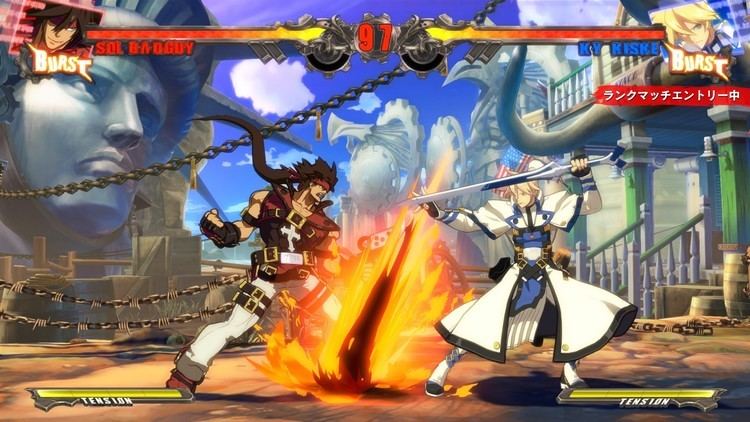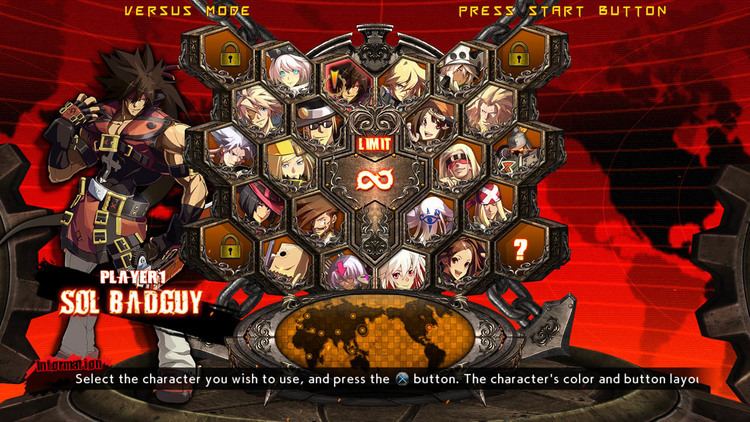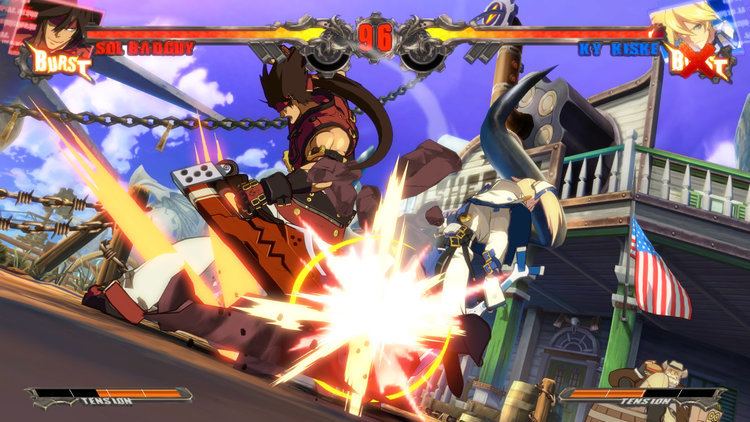8.6 /10 1 Votes
Artist(s) Hidehiko Sakamura Initial release date 20 February 2014 | 8.5/10 IGN | |||||||||||||||||||||||||||||||||
 | ||||||||||||||||||||||||||||||||||
Director(s) Daisuke IshiwatariTakeshi Yamanaka Writer(s) Daisuke IshiwatariTakeshi YamanakaYoshito Shoudai Composer(s) Daisuke IshiwatariNorichika Sato Release date(s) SignArcadeJP: February 20, 2014PS3, PS4JP: December 4, 2014NA: December 16, 2014EU: June 3, 2015 (Digital-only)WindowsWW: December 9, 2015RevelatorArcadeJP: August 25, 2015PS3, PS4JP: May 26, 2016NA: June 7, 2016EU: June 10, 2016WindowsWW: December 14, 2016 Similar Guilty Gear games, Arc System Works games, Fighting games | ||||||||||||||||||||||||||||||||||
Play this game max reviews guilty gear xrd revelator
Guilty Gear Xrd (Japanese: ギルティギア イグザード, Hepburn: Giruti Gia Iguzādo) is a fighting video game developed by Arc System Works. The 5th main (16th overall) installment in the Guilty Gear series, Guilty Gear Xrd was developed using Unreal Engine 3, with cel-shaded graphics in place of the series traditional hand drawn sprites. Following the storyline of the last game in the series, Guilty Gear 2: Overture, it introduced four new characters.
Contents
- Play this game max reviews guilty gear xrd revelator
- Guilty gear xrd revelator official trailer
- Gameplay
- Plot
- Characters
- Development
- Release
- Reception
- Other media
- References

The first Xrd game, Guilty Gear Xrd -Sign- was released in arcades on February 20, 2014, and for the PlayStation 3 and PlayStation 4 in Japan and North America in December of the same year. A digital-only release happened in Europe in June 2015, and it was brought to Microsoft Windows via Steam on December 9, 2015. The game has been praised for its cel-shaded graphics and approachable gameplay, but criticized for its non-interactive story mode and smaller roster of characters.

A sequel follow-up, titled Guilty Gear Xrd -Revelator-, was announced for a Q2 2016 release on consoles. An update title to Revelator titled Guilty Gear Xrd Rev 2 was announced at Arc System Works Fighting Game Award 2016 in January 14, 2017 to be released in Arcade at Spring 2017, while PS3, PS4 and PC versions also announced but the released date after Arcade release remained unknown. The Rev 2 update patch for those who bought Revelator game on PlayStation Store or Steam is also confirmed as a paid-DLC update patch. The PS4 will also receive an exclusive physical disc version.

Guilty gear xrd revelator official trailer
Gameplay
The game uses a six-button layout: five of which are responsible for the attacks—punch, kick, slash, heavy slash and dust—, and the other one for taunting or respecting the other player. There are several other techniques which are triggered when two or three buttons are pressed simultaneously. A burst gauge is filled as time goes by or when the player receives damage; once the gauge is filled, the player can perform a Psych Burst to move away from the opponent. It unleashes a blast of energy that, if it successfully hits the adversary, completely charges another gauge, the tension gauge. The tension gauge allows the player to perform certain other special attacks.
The game features four main modes: Network Mode, Practice Mode, Battle Mode and Story Mode. The first allows online matches through the PlayStation Network (PSN), which may be ranked in world rankings. The Practice Mode features a regular training mode, a tutorial mode that teaches the basic controls, a mission mode that simulates battle situations, and a challenge mode that is focused on performing combos.
The Battle Mode comprises the arcade mode, which unveils part of the game's story after the player defeats eight opponents; a versus mode, in which the player can have offline battles with a second player or against a CPU; and a special "M.O.M" mode. The M.O.M. Mode, which is an acronym for "Medal of Millionaires", is a variation of the regular survival mode in which the player earns medals based on performance and improves through a progression system.
The last mode of Guilty Gear Xrd is the Story Mode, which is new in the current installment. This mode presents the full game story as a film-like animation divided into several chapters, for uninterrupted viewing. The viewer can pause the movie at any time to investigate a glossary of game terms and plot devices, which are described in the library mode.
Plot
The game is set in 2187, one year after its predecessor, Guilty Gear 2: Overture.
It all started in Sign's storyline, the first part is set in arcade mode each characters' own storyline, and focus on Ramlethal Valentine's arc, while the second part of the storyline is set after arcade mode's storyline on console version, focus on after capturing Ramlethal in Conclave and Justice's arc, and also served as the beginning of Elphelt Valentine's arc in the final chapter.
Later in Revelator/Rev 2, the storyline is now focusing on Elphelt Valentine and Jack-O's arc since the final chapter of Sign's story mode on console version.
Characters
The arcade version of the game initially featured thirteen playable characters. Sol Badguy, Ky Kiske, Millia Rage, May, Chipp Zanuff, Potemkin, Venom, Axl Low, I-No, Faust, Slayer, and Zato-1 return from previous installments, while one new character, Bedman, has been added. The game also features a new boss character known as Ramlethal Valentine, who was added to the playable roster in arcades via an update. Additionally, the console versions add Sin Kiske from Overture, and new characters Elphelt Valentine and Leo Whitefang, as playable DLC characters, bringing the total roster count to 17. The console exclusive characters Sin, Elphelt, and Leo were added to the arcade version along with balance changes on March 19, 2015.
The sequel Revelator made balance changes and added Johnny, who was non-playable in Sign's story mode, and a new female character named Jack-O' Valentine. Along with returning Jam Kuradoberi as a playable character, Revelator also gives Sign's newcomer Elphelt a darker look for story purposes. Another returning character, Dizzy, was also added to the playable roster as the result of a fan vote conducted by Arc System Works, defeating Bridget and Baiken in a close race, with a total of 32,990 votes. The new character introduced in Revelator, Kum Haehyun, who is non-playable in the arcade version, was announced as a DLC character for the console version. Raven from Guilty Gear 2: Overture is the last of the six new additions to the Revelator sequel.
Baiken, on the other hand, will return as playable in an updated version of Revelator, Rev 2, followed by a new character who is a chief officer of Chipp Zanuff, Answer.
Development
The idea of creating a new Guilty Gear came in 2008, but production only started in 2011; in mid-2012, it progressed to a full-scale production, concluding in 2013. Development of the game was handled by an internal Arc System Works 25-member team codenamed "Team Red", who had series creator Daisuke Ishiwatari as the director. It was produced by using the Unreal Engine 3 (UE3) because of its low price, the ease that non-programmers can edit it directly, and of porting it to home consoles. Ishiwatari developed the game aiming to reach a wide audience as he planned to make Guilty Gear Xrd a new start on the franchise. As such, he intended to make the gameplay more accessible for newcomer players. A priority to Ishiwatari was to make it a cross-platform game so that PlayStation 3 (PS3) and PlayStation 4 (PS4) owners can play against each other.
The first trailer for Guilty Gear Xrd -Sign- was shown to the public during the annual Arc System Works Festival on May 19, 2013. The trailer demonstrated the 3D cel-shaded graphics—modeled by Softimage—being used in place of the series traditional 2D sprites. The game was projected to be visually impacting as a way to attract new players and because of Ishiwatari's guess that it was a fundamental factor on the success of games like Street Fighter 2 and Virtua Fighter 2. 3D camera cutaways, which gives "a more dramatic perspective", were added on the special move scenes to help reach this purpose. However, this cinematic moves in which the camera orbit the scene required the background objects to be modeled 360 degree. Because of this rotation, special effects such as smoke should be convincing in 3D; so they modeled it with meshs. The objects also had to be scaled down or deformed to give the impression they are far from when they are. Designers did that because if they were actually placed in a far depth, their horizontal movement would seem to be motionless. In contrast, cutscene backgrounds and distant characters in the stages are billboards. Each scene has 160 MB in textures and 70–80 different shaders on it. Each character model uses around 400 to 600 bones, along with significant use of scale animation.
Due to a small development time and budget, Ishiwatari had to carefully choose which characters he preferred to be included in the initial roster, with plans to expand it later. Other factors on this decision was also the variety each character added in terms of gameplay, their role in the story, popularity and balance. Each character had to be rendered four times, and the staff wanted to stylize the 3D models to make them look as close as possible to anime, although some poses did not have the ideal anime feel from just changing the camera angle or perspective. The character's bone proportions would have to be changed, but this was not a function UE3 had by default. Artists chose to use swappable parts instead of having to morph the renders, thereby increasing the variety in movement a character had. In conjunction with making the models appear 2D, they also deliberately cut frames of animation to make them move similarly to the sprites used in previous Guilty Gear games. The staff also found it problematic when characters that were supposed to overlap each other were intersecting, but solved the problem by placing a character a little behind the other on the Z-axis. Natural background lighting was removed in order to eliminate 3-dimensional shading on the characters that made their polygonal format evident.
Release
The first game in the Xrd series, called Guilty Gear Xrd -Sign- was released in Japanese arcades on February 20, 2014, on the Sega RingEdge 2 arcade board with support for the ALL.Net P-ras MULTI Ver.2 system. The game's port to the PlayStation branch was first available in November 2014 through a demo version released on PlayStation Plus for PS4. On December 4 of the same year, it was released both for PS4 and PS3. The PS3 and PS4 versions were released in North America by Aksys Games on December 16, 2014. It was followed by a North America-exclusive limited edition also released for PS3 and PS4 on December 23. In Europe, it was only digitally released by Sony Computer Entertainment through PSN on June 3, 2015. On December 9, 2015, a Microsoft Windows port of the game was released via Steam.
An updated sequel to Sign called Guilty Gear Xrd -Revelator- was announced for the third quarter of 2015 for release on arcades, starting at a test location in June. It was released for Japanese arcades on August 25, 2015. In September, Arc System Works announced a port to PS3 and PS4 whose trailer would be exhibited at the Tokyo Game Show later that month. Aksys Games announced its North American release to coincide with the Japanese release in the second quarter of 2016. However, the English voice option is not included.
Reception
The game has received generally favorable reviews, holding a Metacritic score of 85, based on 23 critics; for 2014, it was the 16th best rated game for PS4 and the 131st overall in the site. Giant Bomb staff chose the game as the Best-Looking Game of 2014, praising the "crazy polygonal anime madness" and highlighting the camera capacity of "revealing the game's true nature" when it revolves around the scenario during a special move. Geoffrey Thew of Hardcore Gamer elected it the third best game of 2014, commenting that "The characters are as vibrant and wonderful as we've come to expect from the company, and the new graphics are beyond gorgeous ... but it's the fighting mechanics that really steal the show." It was also nominated for Best Fighting Game of the Year at Game Critics Awards, Hardcore Gamer Awards, and IGN Awards, but lost to Super Smash Bros. for Wii U in all three. In 2015, Guilty Gear Xrd Sign was nominated for Best Fighting game at The Game Awards 2015, but lost to Mortal Kombat X.
The game has been unanimously praised for its visuals; Electronic Gaming Monthly's Eric L. Patterson complimented it saying "this is the most impressive ... fighting game I've even seen (or played) when it comes to the graphics on display," while Earnest Cavalli of Engadget declared that "[f]rom a purely aesthetic standpoint," Guilty Gear Xrd -Sign- is "faultless." Other very praised aspect was its accessibility, attributed to its equally praised tutorials. GameCentral affirmed it can "may well be the best yet for any fighting game." Darry Husky of IGN asserted, "Guilty Gear Xrd does an admirable job of making it all accessible not only for those of us making the jump from other fighting games, but for those checking the genre out for the very first time."
A common criticism was that one done by GamesTM reviewer, who was disappointed by the game content-wise, citing the few modes and the "pointless" story mode. Cavalli commented Guilty Gear Xrd -Sign-'s "biggest flaw, however, is that it offers players a vibrant world in which they have relatively little to do." James Kozanitis of Hardcore Gamer elected the story mode the game's Achilles heel, while Ben Moore of GameTrailers bemoaned, "It's so full of cliches and caricatures that it's difficult to sit through." Thomas Morgan of Eurogamer considered both arcade and story mode animations skippable. Aevee Bee of Paste was more positive, declaring "given the structure of other fight games stories I'd much rather just watch this". The limited roster of characters were also another major critic; Chris Carter of Destructoid also thought the roster to be small but asserted characters are unique enough to make it good. Similarly, Maxwell McGee from GamesRadar lamented the "several painful absences" but stated new characters "help fill in these vacancies." Conversely, Moore stated, "despite the high level of quality, the cast still feels rather lean."
The cross-play between the PS3 and PS4 was praised by Carter, and was called "a welcome addition" by Husky. Moore commended the "competent, if not exceptional" online mode, while Morgan said it "makes the best of each connection I've had online". Patterson labelled it "absolutely competent—if not a little underachieving" but complained that it had not the lobby interfaces that BlazBlue or Persona 4 Arena had. Moore noted it was "far too many steps for such a simple thing." Kozanitis complained about the online mode, saying it "runs sweet as a nut." The matchmaking lobbies were highly criticized; Cavalli wrote it "feels like a relic from 2005" for it: "It's a total crapshoot, and the game's weak, pre-set communication options don't make things any easier." Mike Williams of USGamer said it "feels like a step backwards" and asserted that "it's a shame, because with a better online system, Guilty Gear Xrd could've been the best of the best."
Cavalli was the most negative reviewer: "For all its good looks, [Guilty Gear Xrd -Sign-] is ultimately disappointing. What the game does, it does very well, but the sum total feels lacking. Had [Guilty Gear Xrd -Sign-] been released 10 years ago, its shortfalls could have been ignored in the face of tight gameplay mechanics and lovely graphics, but in 2014 the game just seems antiquated." However, in overall critics were favorable on their conclusions; it has been described as "the installment fans have been waiting for" by Kozanitis, and "a triumphant, long-awaited return for this venerable fighting game franchise" by Husky. The latter opined that "Xrd has enough new features and mechanics to feel like a true sequel, while excellently retaining many of the classic elements that impart the good old feeling of a Guilty Gear game." Morgan affirmed it is "among the PS4's best presented games to date, and a real highlight of the series." McGee stated, "Taken as a whole, Guilty Gear Xrd Sign is a strong - yet unsurprising - fighting game."
Other media
On April 14, 2014, Arc System Works released an extended play containing the arcade opening and ending themes, "Heavy Day" and "Lily", both in regular and karaoke versions. An original four-disc soundtrack containing 73 tracks was released by Arc System Works on March 26, 2015. Other related media released include an arcade stick, action figures, key chains, mug illustrations, and badges.
